Agrochemicals Market Size
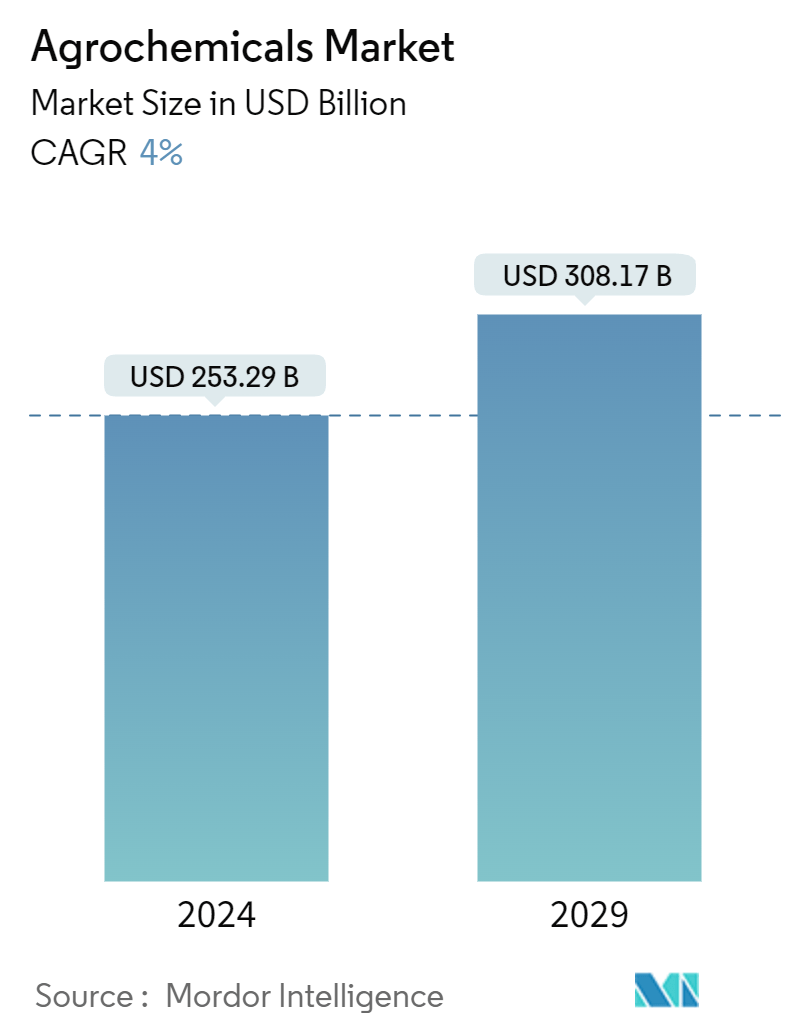
| Study Period | 2019 - 2029 |
| Market Size (2024) | USD 253.29 Billion |
| Market Size (2029) | USD 308.17 Billion |
| CAGR (2024 - 2029) | 4.00 % |
| Fastest Growing Market | North America |
| Largest Market | Asia Pacific |
Major Players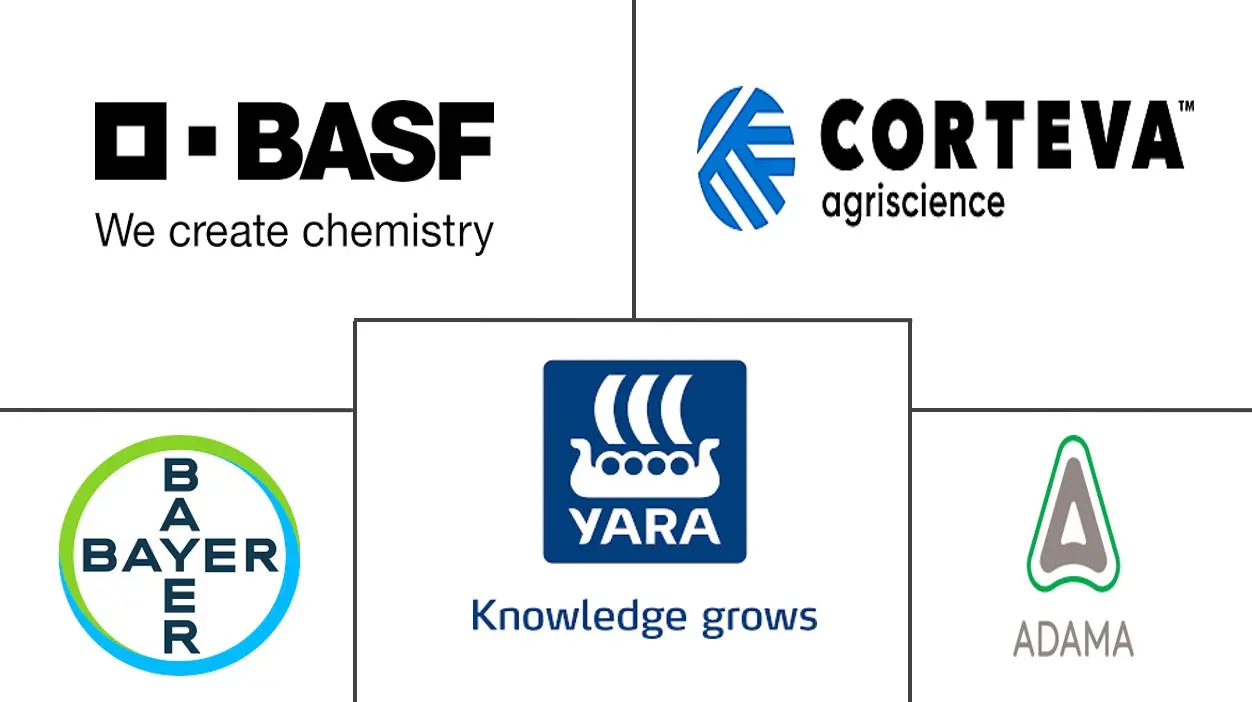
*Disclaimer: Major Players sorted in no particular order |
Agrochemicals Market Analysis
The Agrochemicals Market size is estimated at USD 253.29 billion in 2024, and is expected to reach USD 308.17 billion by 2029, growing at a CAGR of 4% during the forecast period (2024-2029).
The rising population across the world, accompanied by rising affluence, is shifting consumption patterns. There is a need not just to increase production to meet demand but also to ensure that the nutritional needs of an increasingly affluent population are met. Moreover, the demand for healthy diets has increased the consumption of cereals, fruits, and vegetables across the world. This has resulted in integration among growers, federal governments, and industries to improve crop yield to meet global food supply requirements. While all this is done, proper care is applied so as not to cause any adverse effects on human safety and ecological balance.
For instance, according to the IMF, in 2021, the estimated total population in India amounted to approximately 1.39 billion people. According to the FAO, in 2021, 11.7% of the global population experienced severe food insecurity. Shrinking arable land and loss of crops due to pest attacks lead to wastage, posing a critical challenge to ensuring food and nutritional security. According to the US Department of Agriculture, from 2000 onwards, the total land area in the US farms has decreased annually. The total farmland area has decreased by almost 50 million acres, reaching 895.3 million acres as of 2021. Such factors are raising the demand for agrochemicals, which boosts agricultural output.
Agrochemical usage is mainly driven by the growing application of genetically modified crops, such as soybean, maize, and cotton. The increasing application of agrochemicals has increased the need for the availability and production of more inert ingredients in the world.
Moreover, insect pests, plant parasitic nematodes, and fungal diseases continuously evolve and attack plants, leading to decreased yields. Furthermore, the incidence of resistant pests and insects against the existing crop protection chemicals in recent years is leading to the development of new active ingredient agrochemicals, increasing disease incidences. For instance, clubroot is a serious soil-borne disease of cruciferous plants, such as canola. In canola, swellings or galls form on the roots, which can ultimately cause premature death of the plant. About 300 new fields a year in Alberta have been found to have clubroot, and cases have started to spring up in Manitoba and Saskatchewan, Canada’s largest canola growers. There are about 3,000 fields infected with clubroot in Canada, which could devastate the Canadian canola industry. However, there is rampant crop damage due to disease incidence, causing enormous losses to economically important crops. This created the need to develop new fungicides and compelled farmers to adopt an intensified application of agrochemicals such as fungicides and insecticides.
However, regulatory restrictions and environmental concerns are the major factors that can restrain the use of raw materials in agrochemicals. Government regulations and restrictions on using certain raw materials can limit their availability and use in crop protection. For instance, in December 2021, the Government of Mexico passed a decree to eliminate the use of glyphosate-based pesticide products in the country. More pesticides are projected to be eliminated in the coming years amid rising consumer awareness about the impact of pesticides on human and environmental health.
Agrochemicals Market Trends
Fertilizer is the Largest Growing Product Type
The global food consumption rate rises almost ten times faster than local production. The demand for food is growing in most countries despite the slowdown induced by the decline in commodity prices. The global demand for food is projected to more than double by 2050, driven by population growth, rising incomes, rapid urbanization, and changes in regional diets toward greater consumption of higher-value fresh and processed foods. That, in turn, creates new opportunities for farmers and propels the growth of fertilizers in agriculture.
According to FAO, the world population is projected to reach 9 billion by 2050. The increasing population creates a huge demand for food products to feed the population, which is turning into a major challenge with the decreasing farmland. For instance, in 2021, approximately 17.23 million hectares of land in the United Kingdom was classified as the utilized agricultural area, which decreased from 17.27 million hectares in 2020. The shrinking area under agriculture is anticipated to demand more produce from the available land.
However, the increasing need for food security within an expanding population and greater demand from a rising middle class for food variety necessitate the need to boost crop yields, thus driving the demand for fertilizers among farmers.
Additionally, fertilizers are essential in obtaining high yields as these are necessary to increase productivity in the field. Fertilizers are vital to crop growth, showing improved performance and noticeable results. Supplying adequate plant nutrients is essential for healthy growth as well as the production capacity of plants. The nutrient demand varies with crops and soil. These nutrient demands can be effectively fulfilled through the use of chemicals. For instance, urea provides 46% nitrogen to the soil, whereas organic fertilizers like neem cake could provide only 2-5% nitrogen, an essential element for plant growth and development. Thus, to increase productivity from the limited land, the efficient use of inputs is mandatory, driving the fertilizers market as fertilizers are an important input in crop production.
According to the FAO, the NPK fertilizer agricultural use increased by 3.02% in 2019-2020. Nitrogen was the most used fertilizer in 2019, accounting for 417 thousand metric tons. Nitrogen fertilizers are the most consumed fertilizer in Africa. According to the International Fertilizers Association, the total NPK consumption in 2019 accounted for 6,605 thousand metric tons. However, usage remains well below the global average and significantly beneath the targets set by regional governments and intergovernmental organizations despite recent growth in both sales and production. For instance, according to the Africa Fertilizers Organization report, 14 fertilizer manufacturing plants were mapped in 2020. There were 151 fertilizer plants in Africa in 2020, including 87 processing plants, 15 organic plants, and 35 new facilities apart from the manufacturing plants. Malawi accounts for only two fertilizer processing plants, and Zambia has four, whereas Mozambique has five processing plants, one of which was established during the historic period in 2020. Thus, with the increased crop production, the fertilizer market has grown and is anticipated to grow further, with a preference for organic fertilizers for sustainable development.
Furthermore, more than 11% of the world’s fertilizers are supplied by Canada. In the past few years, the Canadian government has also taken several steps to promote sustainable fertilizer production in the country. Under current circumstances, Canada aims to improve fertilizer production and consumption scenario while maintaining environmental harmony. For instance, in July 2022, Canada's Minister of Agriculture and Agri-Food announced a CAD 1,685,858 investment in Sulvaris in Calgary, Alberta, for the further development of Sulvaris' carbon control technology, which produces high-efficiency fertilizers made with organic carbon.
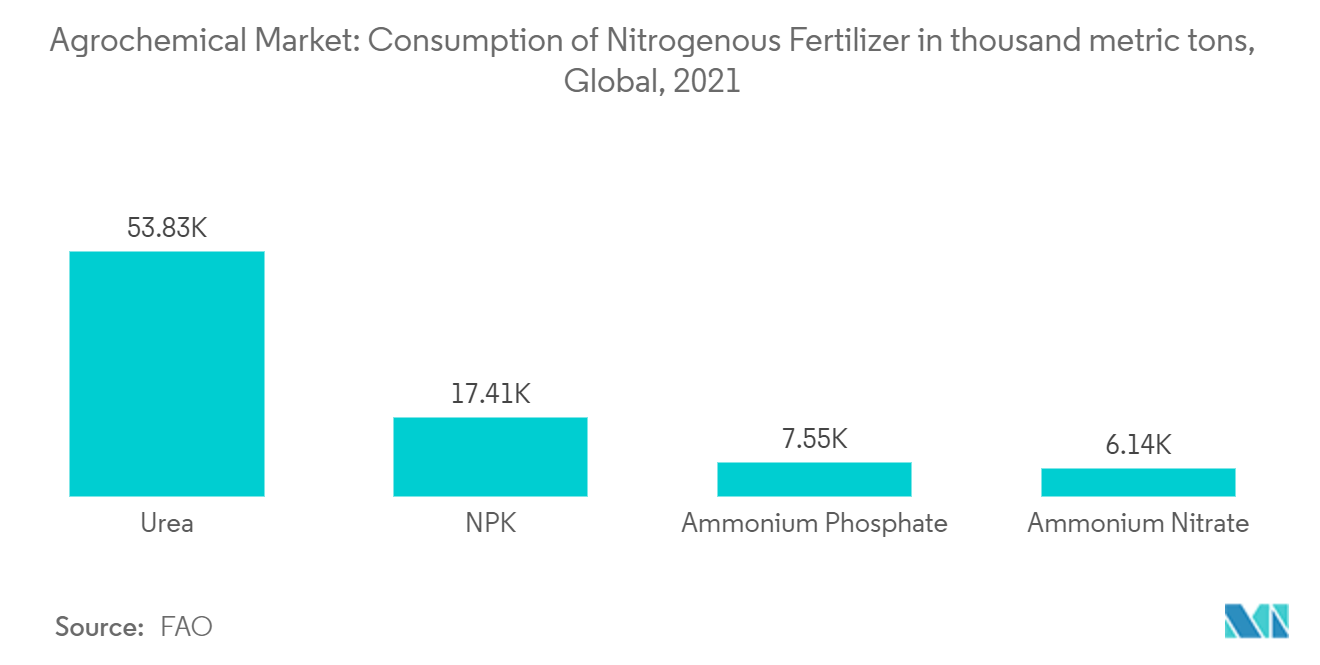
Asia-Pacific is the Largest Segment in the Market
China accounts for the largest share of the agrochemicals market globally. Due to the decreasing cropland area, Chinese consumption of organic N, P, and K fertilizers is decreasing. For instance, according to the China Green Food Development Center, in 2021, approximately 9.84 million hectares of farmland had been certified as organic farmland in China, which has decreased from 13.9 million hectares in 2019. The cropland area under fruits and vegetables is increasing, while the area under cereals is decreasing.
Furthermore, according to the Australian Bureau of Statistics, farmers reportedly spend USD 180 million each year controlling pest infestation in their farms to produce more and enhance the country's sector growth. Also, according to Safe and Effective Pesticide Applications (SEPA), more than 8000 pesticide products are formally registered for use in Australia, and around 75% of these are used for agricultural purposes. The Australian government heavily invests in research and development to increase crop production efficiency and pest management. For instance, the Australian government provided Plant Health Australia with USD 600,000 in 2020 to address critical gaps in national research and development identified in a national workshop.
Similarly, the large production of cereal crops, like rice and wheat, in India is the major factor supporting the market's growth. The use of pesticides is rising steadily in India. Revenues of a few leading pesticides and agrochemical companies as of June 2022 were a clear indication of the growth of the agrochemical market in the country and the region.
The government of India has been constantly adopting practices that have been advantageous in augmenting the accessibility and utilization of agrochemicals in India. According to FAO, in 2022. India accounts for 15.3% of the World’s consumption of (N), 19 % (P), and 14.4% (K), owing to the large production of cereal crops, like rice and wheat in India. In spite of ranking as the second-largest nitrogenous fertilizer producer and third-largest phosphatic fertilizer producer in the world, the demand-supply gap of fertilizers in India is increasing continuously. It is leading to increased dependency on fertilizer imports.
In addition, UPL is the leading pesticides and agrochemical company in India based on net sales worth over INR 164 billion (USD 1.98 billion) as of June 2022. The company was followed by BASF India, which ranked in second place with net sales of roughly INR 130 billion (USD 1.57 billion). Data reveals that only eight states account for more than 70.0% of the total pesticide consumption in India. With a growing emphasis on the environment and sustainability, various governments in the region are enforcing clean production and environment-friendly agriculture policies, which may lead to a decline in synthetic pesticide usage in the country. However, the government has encouraged the use of microbial pesticides, which are projected to grow rapidly in the coming years.
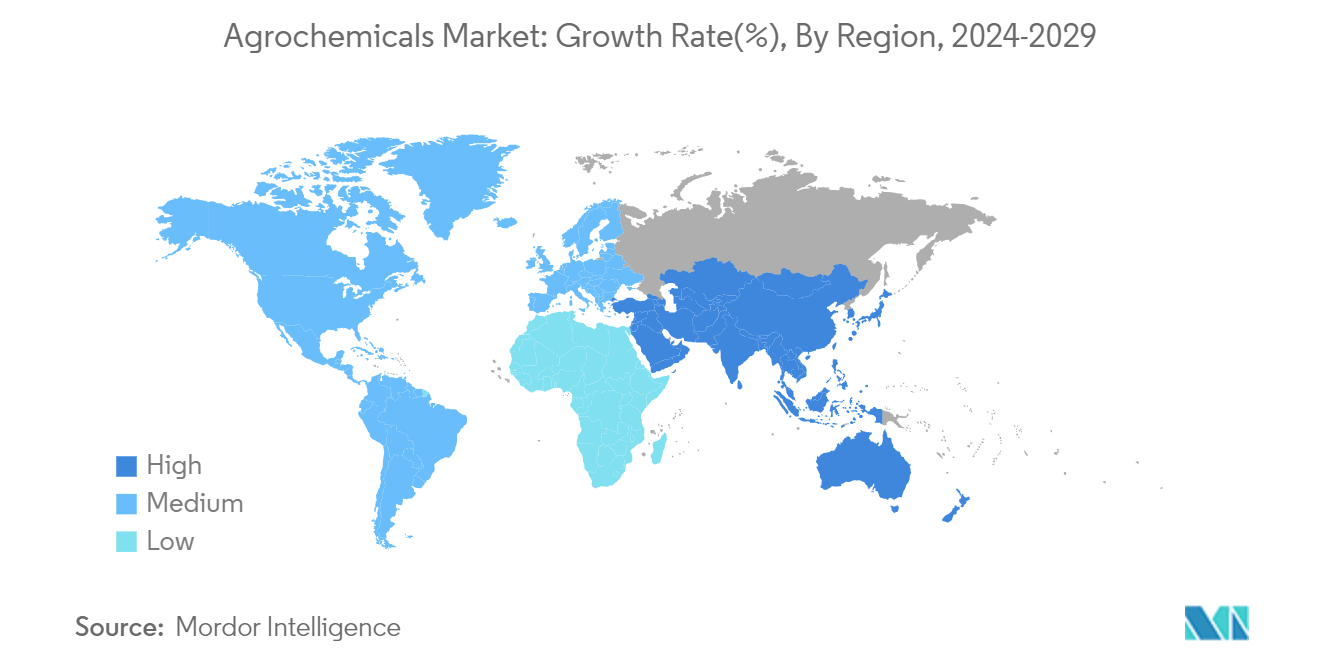
Agrochemicals Industry Overview
The global agrochemicals market is fragmented, with major players including Bayer Crop Science AG, Adama Agricultural Solutions, Yara International ASA, BASF SE, Corteva Agriscience, and Nufarm. New product launches, mergers and acquisitions, and partnerships are the major strategies adopted by these leading companies in the market. Market players are focusing on investments in innovation, collaborations, and expansions to increase their market share.
Agrochemicals Market Leaders
-
BASF SE
-
Corteva Agriscience
-
Yara International ASA
-
Bayer Crop Science
-
Adama Agricultural Solutions
*Disclaimer: Major Players sorted in no particular order
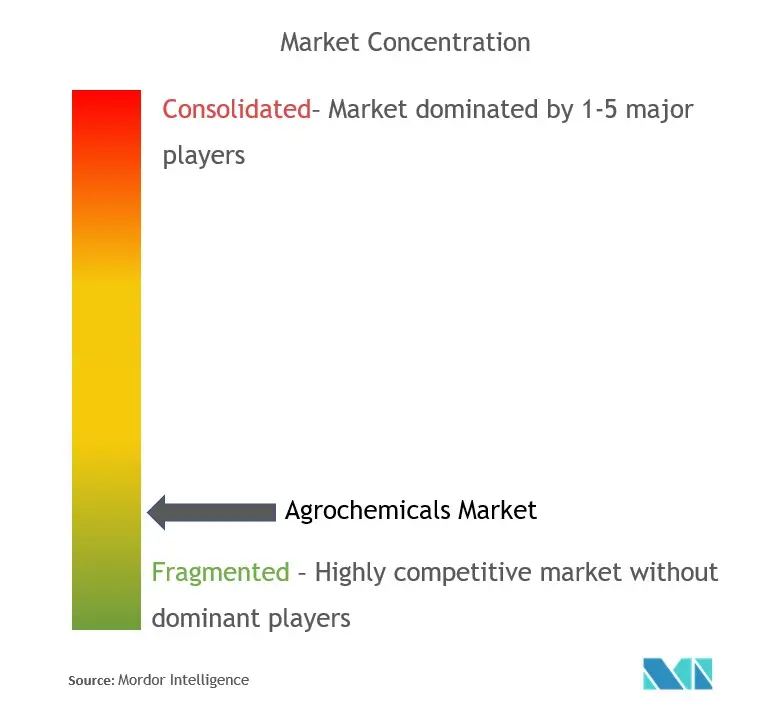
Agrochemicals Market News
- May 2024: Adama Ltd, a leading global crop protection company, launched the EDAPTIS herbicide in Poland. However, EDAPTIS is a ready-to-use solution that provides broad-spectrum control of grassy weeds and improved efficacy in combating resistant populations.
- December 2023: Crystal Crop Protection Limited acquired the trademark GRAMOXONE for the Indian market from Syngenta, a global industry leader in agriculture.
- July 2023: Syngenta India launched Incipio and Simodis, which effectively curb pests like leaf folders, stem borer, and sucking insects which severely reduce the yields in paddy, cotton, and vegetable crops.
Agrochemicals Market Report - Table of Contents
1. INTRODUCTION
- 1.1 Study Assumptions and Market Definition
- 1.2 Scope of the Study
2. RESEARCH METHODOLOGY
3. EXECUTIVE SUMMARY
4. MARKET DYNAMICS
- 4.1 Market Overview
-
4.2 Market Drivers
- 4.2.1 Increasing Demand for Food Due to High Population Growth
- 4.2.2 Adoption of Sustainable Farming Practices
- 4.2.3 Need for Increased Land Productivity
-
4.3 Market Restraints
- 4.3.1 Environmental and Regulatory Constraints
- 4.3.2 Increased Cost and Difficulty with Product Development
-
4.4 Industry Attractiveness - Porter's Five Forces Analysis
- 4.4.1 Bargaining Power of Suppliers
- 4.4.2 Bargaining Power of Buyers
- 4.4.3 Threat of New Entrants
- 4.4.4 Threat of Substitute Products
- 4.4.5 Intensity of Competitive Rivalry
5. MARKET SEGMENTATION
-
5.1 Product Type
- 5.1.1 Fertilizers
- 5.1.2 Pesticides
- 5.1.3 Adjuvants
- 5.1.4 Plant Growth Regulators
-
5.2 Application
- 5.2.1 Crop-based
- 5.2.1.1 Grains and Cereals
- 5.2.1.2 Pulses and Oilseeds
- 5.2.1.3 Fruits and Vegetables
- 5.2.2 Non-crop-based
- 5.2.2.1 Turf and Ornamental Grass
- 5.2.2.2 Other Non-crop-based
-
5.3 Geography
- 5.3.1 North America
- 5.3.1.1 United States
- 5.3.1.2 Canada
- 5.3.1.3 Mexico
- 5.3.1.4 Rest of North America
- 5.3.2 Europe
- 5.3.2.1 Spain
- 5.3.2.2 United Kingdom
- 5.3.2.3 France
- 5.3.2.4 Germany
- 5.3.2.5 Russia
- 5.3.2.6 Italy
- 5.3.2.7 Rest of Europe
- 5.3.3 Asia-Pacific
- 5.3.3.1 China
- 5.3.3.2 India
- 5.3.3.3 Japan
- 5.3.3.4 Australia
- 5.3.3.5 Rest of Asia Pacific
- 5.3.4 South America
- 5.3.4.1 Brazil
- 5.3.4.2 Argentina
- 5.3.4.3 Rest of South America
- 5.3.5 Africa
- 5.3.5.1 South Africa
- 5.3.5.2 Rest of Africa
6. COMPETITIVE LANDSCAPE
- 6.1 Most Adopted Strategies
- 6.2 Market Share Analysis
-
6.3 Company Profiles
- 6.3.1 Bayer Crop Science AG
- 6.3.2 BASF SE
- 6.3.3 Corteva Agriscience AG
- 6.3.4 Archer-Daniels-Midland (ADM)
- 6.3.5 FMC Corporation
- 6.3.6 Adama Agricultural Solutions
- 6.3.7 Potash Corporation of Saskatchewan
- 6.3.8 Nufarm Ltd
- 6.3.9 Nutrien Ltd
- 6.3.10 Yara International ASA
- *List Not Exhaustive
7. MARKET OPPORTUNITIES AND FUTURE TRENDS
** Subject To AvailablityAgrochemicals Industry Segmentation
Agrochemicals are used to prevent the deterioration of crops from insects and pest infestation and disease. The agrochemicals market report offers the latest trends, growth factors, industry competitiveness, investment opportunities, and a detailed profile of the top players in the market.
The agrochemicals market is segmented by product type (fertilizers, pesticides, adjuvants, and plant growth regulators ), application (crop-based and non-crop-based), and geography (North America, Europe, Asia-Pacific, South America, and Africa). The report offers market size and forecasts for the market in terms of value in USD for all the above segments.
| Product Type | Fertilizers | |
| Pesticides | ||
| Adjuvants | ||
| Plant Growth Regulators | ||
| Application | Crop-based | Grains and Cereals |
| Pulses and Oilseeds | ||
| Fruits and Vegetables | ||
| Application | Non-crop-based | Turf and Ornamental Grass |
| Other Non-crop-based | ||
| Geography | North America | United States |
| Canada | ||
| Mexico | ||
| Rest of North America | ||
| Geography | Europe | Spain |
| United Kingdom | ||
| France | ||
| Germany | ||
| Russia | ||
| Italy | ||
| Rest of Europe | ||
| Geography | Asia-Pacific | China |
| India | ||
| Japan | ||
| Australia | ||
| Rest of Asia Pacific | ||
| Geography | South America | Brazil |
| Argentina | ||
| Rest of South America | ||
| Geography | Africa | South Africa |
| Rest of Africa |
Agrochemicals Market Research FAQs
How big is the Agrochemicals Market?
The Agrochemicals Market size is expected to reach USD 253.29 billion in 2024 and grow at a CAGR of 4% to reach USD 308.17 billion by 2029.
What is the current Agrochemicals Market size?
In 2024, the Agrochemicals Market size is expected to reach USD 253.29 billion.
Who are the key players in Agrochemicals Market?
BASF SE, Corteva Agriscience, Yara International ASA, Bayer Crop Science and Adama Agricultural Solutions are the major companies operating in the Agrochemicals Market.
Which is the fastest growing region in Agrochemicals Market?
North America is estimated to grow at the highest CAGR over the forecast period (2024-2029).
Which region has the biggest share in Agrochemicals Market?
In 2024, the Asia Pacific accounts for the largest market share in Agrochemicals Market.
What years does this Agrochemicals Market cover, and what was the market size in 2023?
In 2023, the Agrochemicals Market size was estimated at USD 243.16 billion. The report covers the Agrochemicals Market historical market size for years: 2019, 2020, 2021, 2022 and 2023. The report also forecasts the Agrochemicals Market size for years: 2024, 2025, 2026, 2027, 2028 and 2029.
What are the key drivers of the Agrochemicals Market?
The key drivers of the Agrochemicals Market are a) Growing demand for high-quality, blemish-free produce fuels the use of crop protection chemicals to maintain aesthetics and marketability b) Farmers increasingly utilize agrochemicals to maximize crop yields and meet growing food demands
What are the key drivers of the Agrochemicals Market?
The key drivers of the Agrochemicals Market are a) Growing demand for high-quality, blemish-free produce fuels the use of crop protection chemicals to maintain aesthetics and marketability b) Farmers increasingly utilize agrochemicals to maximize crop yields and meet growing food demands
Agrochemicals Industry Report
The global agrochemicals market is experiencing remarkable growth, fueled by the increasing demand for fertilizers and pesticides essential for boosting agricultural productivity to satisfy the food requirements of a growing global population. This surge is further supported by innovations within the feed and animal husbandry sectors, together with advancements in product development and diagnostics in the agrochemicals industry. Notably, the Asia-Pacific region, especially India and China, is leading in consumption, mirroring the global trend towards enhanced agricultural production.
The competitive landscape of the market is vibrant, with key players engaging in strategic mergers, acquisitions, and launching innovative products to strengthen their market position and meet the varied demands of agriculture. Insights from Mordor Intelligence™ point towards continued expansion, emphasizing the crucial role agrochemicals play in contemporary farming practices. The global industry outlook reveals that the market size is increasing, supported by comprehensive industry analysis and market analysis.
The market share of key players is significant, reflecting the industry's dynamic nature. Industry research indicates that market trends and industry growth are driven by market value and market segmentation. The industry forecast and market overview highlight the potential for further development, with industry statistics showing a positive trend. Market reports and industry reports provide detailed insights into the industry's performance, while industry information and market data offer valuable context for stakeholders.
The growth rate of the agrochemicals market is impressive, with market leaders setting the pace for innovation and expansion. Market predictions and market review suggest a promising future, supported by robust market outlook and industry trends. The market forecast indicates sustained growth, with the industry size expected to increase. Industry sales are projected to rise, driven by market growth and the strategic initiatives of research companies.
For a comprehensive understanding of the market, a report example and report pdf are available, offering detailed industry reports and market analysis. These resources provide an in-depth look at the market's performance, supported by extensive industry research and market data. The report highlights the importance of agrochemicals in modern agriculture, emphasizing their role in enhancing productivity and meeting global food demands.



